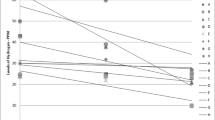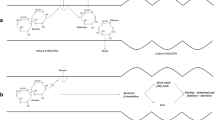Abstract
In a previous study we observed a clear difference in lactose intolerance symptoms after a 25-g lactose load in two groups of persons with lactase nonpersistence and similar small intestinal lactase activity. From this observation we hypothesized a colon resistance factor. To identify this factor, the microbial composition of fecal samples of the two lactose intolerant groups (one with mild symptoms, n = 16, and one with diarrhea-predominant symptoms, n = 11) was compared using the fluorescent in situ hybridization technique. Large interindividual differences were found in the numbers of total bacteria and main groups of bacteria (CV: 0.65 and 0.64–0.82 respectively). The bacterial numbers were not significantly different between the two groups. A significant negative correlation, however, was found between the individual symptom scores of the intolerant persons and the numbers of total hybridizable bacteria (r s = −0.42, P = 0.03). The results suggest that an increased number of bacteria might contribute—by means of a higher fermentative capacity—to the reduction of lactose intolerance symptoms.
Similar content being viewed by others
REFERENCES
Honkanen R, Kroger H, Alhava E, Turpeinen P, Tuppurainen M, Saarikoski S: Lactose intolerance associated with fractures of weight-bearing bones in Finnish women aged 38-57 years. Bone 21(6):473–477, 1997
Di Stefano M, Veneto G, Malservisi S, Cecchetti L, Minguzzi L, Strocchi A, Corazza GR: Lactose malabsorption and intolerance and peak bone mass. Gastroenterology 122(7):1793–1799, 2002
Cavalli-Sforza LT, Strata A: Double-blind study on the tolerance of four types of milk in lactose malabsorbers and absorbers. Hum Nutr Clin Nutr 41(1):19–30, 1987
Ceriani R, Galli L, Reali E: The use of H2 breath test in assessment of quantitative lactose malabsorption and milk intake. J Pediatr Gastroenterol Nutr 12(1):141–142, 1991
de Vrese M, Stegelmann A, Richter B, Fenselau S, Laue C, Schrezenmeir J: Probiotics-Compensation for lactase insufficiency. Am J Clin Nutr 73(2, Suppl):421S–429S, 2001
Suarez FL, SavaianoDA, Levitt M: Acomparison of symptoms after the consumption of milk or lactose-hydrolyzed milk by people with self-reported severe lactose intolerance. N Engl J Med 333(1):1–4, 1995
Vonk RJ, Priebe MG, Koetse HA, Stellaard F, Lenoir-Wijnkoop I, Antoine JM, Zhong Y, Huang CY: Lactose intolerance: analysis of underlying factors. Eur J Clin Invest 33:70–75, 2003
Bond JH, Currier BE, Buchwald H, Levitt MD: Colonic conservation of malabsorbed carbohydrate.Gastroenterology 78(3):444–447, 1980
Ward DM, Weller R, Bateson MM: 16S rRNA sequences reveal numerous uncultured microorganisms in a natural community. Nature 345(6270):63–65, 1990
Nelson GM, George SE: Comparison of media for selection and enumeration of mouse fecal flora populations. J Microbial Methods 22:293–300, 1995
Harmsen HJ, Gibson GR, Elfferich P, Raangs GC, Wildeboer-Veloo AC, Argaiz A, Roberfroid MB, Welling GW: Comparison of viable cell counts and fluorescence in situ hybridization using specific rRNA-based probes for the quantification of human fecal bacteria. FEMS Microbiol Lett 183(1):125–129, 2000
Amann RI, Krumholz L, Stahl DA: Fluorescent-oligonucleotide probing of whole cells for determinative, phylogenetic, and environmental studies in microbiology. J Bacteriol 172(2):762–770, 1990
Franks AH, Harmsen HJ, Raangs GC, Jansen GJ, Schut F, Welling GW: Variations of bacterial populations in human feces measured by fluorescent in situ hybridization with group-specific 16S rRNA-targeted oligonucleotide probes. Appl Environ Microbiol 64(9):3336–33345, 1998
Langendijk PS, Schut F, Jansen GJ, Raangs GC, Kamphuis GR, Wilkinson MH, Welling GW: Quantitative fluorescence in situ hybridization of bifidobacterium spp. with genus-specific 16S rRNA-targeted probes and its application in fecal samples. Appl Environ Microbiol 61(8):3069–3075, 1995
Vonk RJ, Lin Y, Koetse HA, Huang C, Zeng G, Elzinga H, Antoine JM, Stellaard F: Lactose (mal)digestion evaluated by the 13C-lactose digestion test. Eur J Clin Invest 30(2):140–146, 2000
Jansen G J, Wildeboer-Veloo AC, Tonk RH, Franks AH, Welling GW: Development and validation of an automated, microscopy-based method for enumeration of groups of intestinal bacteria. J Microbiol Methods 37(3):215–221, 1999
Tannock GW, Munro K, Harmsen HJ, Welling GW, Smart J, Gopal PK: Analysis of the fecal microflora of human subjects consuming a probiotic product containing lactobacillus rhamnosus DR20. Appl Environ Microbiol 66(6):2578–2588, 2000
Harmsen HJ, Wildeboer-Veloo AC, Grijpstra J, Knol J, Degener JE, Welling GW: Development of 16S rRNA-based probes for the coriobacterium group and the atopobium cluster and their application for enumeration of coriobacteriaceae in human feces from volunteers of different age groups. Appl Environ Microbiol 66(10):4523–4527, 2000
Moter A, Gobel UB: Fluorescence in situ hybridization (FISH) for direct visualization of microorganisms. J Microbiol Methods 41(2):85–112, 2000
Alm EW, Oerther DB, Larsen N, Stahl DA, Raskin L: The oligonucleotide probe database. Appl Environ Microbiol 62(10):3557–3559, 1996
Harmsen HJ, Raangs GC, He T, Degener JE, Welling GW: Extensive set of 16S rRNA-based probes for detection of bacteria in human feces. Appl Environ Microbiol 68(6):2982–2990, 2002
Arola H, Tamm A: Metabolism of lactose in the human body. Scand J Gastroenterol Suppl 202:21–25, 1994
Hill MJ: Bacterial adaptation to lactase deficiency. In Milk Intolerances and Rejection. J Delmont (ed). Basel, Karger, 1983, pp 22–26
Holtug K, Clausen MR, Hove H, Christiansen J, Mortensen PB: The colon in carbohydrate malabsorption: Short-chain fatty acids, pH, and osmotic diarrhoea. Scand J Gastroenterol 27(7):545–552, 1992
Treem WR, Ahsan N, Kastoff G, Hyams JS: Fecal short-chain fatty acids in patients with diarrhea-predominant irritable bowel syndrome: in vitro studies of carbohydrate fermentation. Pediatr Gastroenterol Nutr 23(3):280–286, 1996
Clausen MR, Bonnen H, Tvede M, Mortensen PB: Colonic fermentation to short-chain fatty acids is decreased in antibiotic-associated diarrhea. Gastroenterology 101(6):1497–1504, 1991
Clausen MR, Mortensen PB. Lactulose, disaccharides and colonic flora. Clinical consequences. Drugs 53(6):930-942, 1997
Ruppin H, Bar-Meir S, Soergel KH, Wood CM, Schmitt MG Jr: Absorption of short-chain fatty acids by the colon. Gastroenterology 78(6):1500–1507, 1980
Ballongue J, Schumann C, Quignon: Effects of lactulose and lactitol on colonic microflora and enzymatic activity. Scand J Gastroenterol Suppl 222:41–44, 1997
Amann RI, Binder BJ, Olson RJ, Chisholm SW, Devereux R, Stahl DA: Combination of 16S rRNA-targeted oligonucleotide probes with flow cytometry for analyzing mixed microbial populations. Appl Environ Microbiol 56(6):1919–1925, 1990
Manz W, Amann R, Ludwig W, Vancanneyt M, Schleifer KH: Application of a suite of 16S rRNA-specific oligonucleotide probes designed to investigate bacteria of the phylum Cytophaga-Flavobacter-Bacteroides in the natural environment. Microbiology 142(Pt 5):1097–1106, 1996
Wilson KH, Blitchington RB: Human colonic biota studied by ribosomal DNA sequence analysis. Appl Environ Microbiol 62(7):2273–2278, 1996
Priebe, MG, Vonk RJ, Sun X, He T, Harmsen HJM, Welling GJ: The physiology of colonic metabolism. Possibilities for interventions with pre-and probiotics. Eur J Nutr Suppl 1:I2–I10, 2002
Author information
Authors and Affiliations
Rights and permissions
About this article
Cite this article
Zhong, Y., Priebe, M.G., Vonk, R.J. et al. The Role of Colonic Microbiota in Lactose Intolerance. Dig Dis Sci 49, 78–83 (2004). https://doi.org/10.1023/B:DDAS.0000011606.96795.40
Issue Date:
DOI: https://doi.org/10.1023/B:DDAS.0000011606.96795.40




